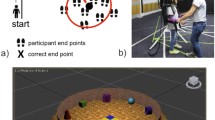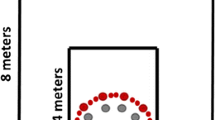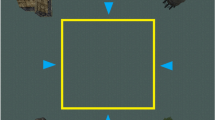Abstract
Older adults demonstrate impairments in navigation that cannot be explained by general cognitive and motor declines. Previous work has shown that older adults may combine sensory cues during navigation differently than younger adults, though this work has largely been done in dark environments where sensory integration may differ from full-cue environments. Here, we test whether aging adults optimally combine cues from two sensory systems critical for navigation: vision (landmarks) and body-based self-motion cues. Participants completed a homing (triangle completion) task using immersive virtual reality to offer the ability to navigate in a well-lit environment including visibility of the ground plane. An optimal model, based on principles of maximum-likelihood estimation, predicts that precision in homing should increase with multisensory information in a manner consistent with each individual sensory cue’s perceived reliability (measured by variability). We found that well-aging adults (with normal or corrected-to-normal sensory acuity and active lifestyles) were more variable and less accurate than younger adults during navigation. Both older and younger adults relied more on their visual systems than a maximum likelihood estimation model would suggest. Overall, younger adults’ visual weighting matched the model’s predictions whereas older adults showed sub-optimal sensory weighting. In addition, high inter-individual differences were seen in both younger and older adults. These results suggest that older adults do not optimally weight each sensory system when combined during navigation, and that older adults may benefit from interventions that help them recalibrate the combination of visual and self-motion cues for navigation.






Similar content being viewed by others
Data availability
The raw data, processing script, and analysis script for this study are available on Open Science Framework at the link below. The virtual environment build will be provided upon request. https://doi.org/10.17605/OSF.IO/P4QTV
Notes
While the Romberg test was intended as a screening tool, \(post-hoc\) Pearson correlation showed no relationship between visual sway ratio (Assländer and Peterka 2014) and visual cue weighting for navigation (defined later) for both younger (\(R^{2}\) = 0.04, p = 0.35) and older adults (\(R^{2}\) = 0.01, p = 0.75)
The real world experiment measured homing position data differently than the VR experiment because of the need to measure performance in the real world without a VR tracking system. Specifically, only absolute error (distance from the home target), not direction of error, was recorded in the real world. This particularly affected the measurements needed for the weights derived from the conflict condition. Given that a primary goal of this paper is to test a model of optimal cue combination in navigation in a virtual environment, the real world and VR experiments are not directly compared in this paper.
\(Post-hoc\) paired t-tests did not show order effects for younger adults in either accuracy (t(23) = 0.17, p = 0.87) or variability (t(23) = 0.99, p = 0.32) of navigational performance.
References
Adamo DE, Briceño EM, Sindone JA, Alexander NB, Moffat SD (2012) Age differences in virtual environment and real world path integration. Front Aging Neurosci 4:1–9. https://doi.org/10.3389/fnagi.2012.00026
Allen GL, Kirasic KC, Rashotte MA, Haun DBM (2004) Aging and path integration skill: Kinesthetic and vestibular contributions to wayfinding. Percep Psychophys 66(1):170–179. https://doi.org/10.3758/BF03194870
Assländer L, Peterka RJ (2014) Sensory reweighting dynamics in human postural control. J Neurophysiol 111(18):52–64. https://doi.org/10.1152/jn.00669.2013
Barhorst-Cates EM, Rand KM, Creem-Regehr SH (2017) Let me be your guide: physical guidance improves spatial learning for older adults with simulated low vision. Exp Brain Res 235:3307–3317
Bates D, Mächler M, Bolker B, Walker S (2015) Fitting linear mixed-effects models using lme4. J Stat Softw 67(1):1–48. https://doi.org/10.18637/jss.v067.i01
Bates SL, Wolbers T (2014) How cognitive aging affects multisensory integration of navigational cues. Neurobiol Aging 3512:2761–2769. https://doi.org/10.1016/j.neurobiolaging.2014.04.003
Chen X, McNamara TP, Kelly JW, Wolbers T (2017) Cue combination in human spatial navigation. Cogn Psychol 95:105–144. https://doi.org/10.1016/j.cogpsych.2017.04.003
Chrastil ER, Nicora GL, Huang A (2019) Vision and proprioception make equal contributions to path integration in a novel homing task. Cognition 192:103998
Coughlan G, Laczó J, Hort J, Minihane AM, Hornberger M (2018) Spatial navigation deficits—overlooked cognitive marker for preclinical Alzheimer disease? Nat Rev Neurol 148:496–506. https://doi.org/10.1038/s41582-018-0031-x
Creem-Regehr SH, Kelly JW, Bodenheimer B, Stefanucci JK (2024) Virtual reality as a tool to understand spatial navigation. Reference module in neuroscience and biobehavioral psychology
de Dieuleveult AL, Siemonsma PC, van Erp JB, Brouwer AM (2017) Effects of aging in multisensory integration: a systematic review. Front Aging Neurosci 9:1–14. https://doi.org/10.3389/fnagi.2017.00080
Diersch N, Wolbers T (2019) The potential of virtual reality for spatial navigation research across the adult lifespan. J Exp Biol 222:jeb187252
Ernst MO, Banks MS (2002) Humans integrate visual and haptic information in a statistically optimal fashion. Nature 4156870:429–433. https://doi.org/10.1038/415429a
Head D, Isom M (2010) Age effects on wayfinding and route learning skills. Behav Brain Res 209(1):49–58. https://doi.org/10.1016/j.bbr.2010.01.012
Hegarty M, Waller D (2005) Individual differences in spatial abilities. The Cambridge handbook of visuospatial thinking, pp 121–169
Hicks CW, Wang D, Windham BG, Matsushita K, Selvin E (2021) Prevalence of peripheral neuropathy defined by monofilament insensitivity in middle-aged and older adults in two US cohorts. Sci Rep 11(1):19159. https://doi.org/10.1038/s41598-021-98565-w
Humes LE (2015) Age-related changes in cognitive and sensory processing: focus on middle-aged adults. Am J Audiol 24(2):94–97. https://doi.org/10.1044/2015_AJA-14-0063
Iggena D, Jeung S, Maier PM, Ploner CJ, Gramann K, Finke C (2023) Multisensory input modulates memory-guided spatial navigation in humans. Commun Biol 6(1):1167
Jicol C, Lloyd-Esenkaya T, Proulx MJ, Lange-Smith S, Scheller M, O’Neill E, Petrini K (2020) Efficiency of sensory substitution devices alone and in combination with self-motion for spatial navigation in sighted and visually impaired. Front Psychol 11:1443. https://doi.org/10.3389/fpsyg.2020.01443
Jones SA, Noppeney U (2021) Ageing and multisensory integration: a review of the evidence, and a computational perspective. Cortex 138:1–23. https://doi.org/10.1016/j.cortex.2021.02.001
Kotecha A, Chopra R, Fahy RT, Rubin GS (2013) Dual tasking and balance in those with central and peripheral vision loss. Investig Ophthalmol Vis Sci 548:5408–5415
Kuznetsova A, Brockhoff PB, Christensen RHB (2017) lmerTest package: tests in linear mixed effects models. J Stat Softw 82(13):1–26. https://doi.org/10.18637/jss.v082.i13
Lester AW, Moffat SD, Wiener JM, Barnes CA, Wolbers T (2017) The aging navigational system. Neuron 955:1019–1035. https://doi.org/10.1016/j.neuron.2017.06.037
Levine TF, Dessenberger SJ, Allison SL, Head D, Initiative ADN (2023) Alzheimer disease biomarkers are associated with decline in subjective memory, attention, and spatial navigation ability in clinically normal adults. J Int Neuropsychol Soc 1–15
Loomis JM, Lippa Y, Klatzky RL, Golledge RG (2002) Spatial updating of locations specified by 3-d sound and spatial language. J Exp Psychol Learn Memory Cogn 282:335
Lüdecke D, Ben-Shachar MS, Patil I, Waggoner P, Makowski D (2021) Performance: an R package for assessment, comparison and testing of statistical models. J Open Source Softw 660:3139. https://doi.org/10.21105/joss.03139
McAvan AS, Du YK, Oyao A, Doner S, Grilli MD, Ekstrom A (2021) Older adults show reduced spatial precision but preserved strategy-use during spatial navigation involving body-based cues. Front Aging Neurosci 13:640188
Meng J, Sedgwick H (2002) Distance perception across spatial discontinuities. Percep Psychophys 64:1–14
Moffat SD (2009) Aging and spatial navigation: what do we know and where do we go? Neuropsychol Rev 19:478–489
Morey RD, Rouder JN (2011) Bayes factor approaches for testing interval null hypotheses. Psychol Methods 16(4):406–419. https://doi.org/10.1037/a0024377
Morey RD, Rouder JN (2023) Bayesfactor: computation of bayes factors for common designs [Computer software manual]. R package version 0.9.12-4.6
Mou W, Spetch ML (2013) Object location memory: integration and competition between multiple context objects but not between observers’ body and context objects. Cognition 126(2):181–197. https://doi.org/10.1016/j.cognition.2012.09.018
Muffato V, De Beni R (2020) Path learning from navigation in aging: the role of cognitive functioning and wayfinding inclinations. Front Hum Neurosci 14:8. https://doi.org/10.3389/fnhum.2020.00008
Nardini M, Jones P, Bedford R, Braddick O (2008) Development of cue integration in human navigation. Curr Biol 18(9):689–693. https://doi.org/10.1016/j.cub.2008.04.021
Newcombe NS, Hegarty M, Uttal D (2023) Building a cognitive science of human variation: individual differences in spatial navigation. Topics Cogn Sci 15(1):6
Newman PM, McNamara TP (2021) A comparison of methods of assessing cue combination during navigation. Behav Res Methods 531:390–398. https://doi.org/10.3758/s13428-020-01451-y
Newman PM, Qi Y, Mou W, McNamara TP (2023) Statistically optimal cue integration during human spatial navigation. Psychon Bull Rev. https://doi.org/10.3758/s13423-023-02254-w
R Core Team (2022) R: A language and environment for statistical computing [Computer software manual]. Vienna, Austria https://www.R-project.org/
Rahnev D, Denison RN (2018) Suboptimality in perceptual decision making. Behav Brain Sci 41:e223. https://doi.org/10.1017/S0140525X18000936
Ramkhalawansingh R, Butler JS, Campos JL (2018) Visual-vestibular integration during self-motion perception in younger and older adults. Psychol Aging 33(5):798–813. https://doi.org/10.1037/pag0000271
Rand KM, Creem-Regehr SH, Thompson WB (2015) Spatial learning while navigating with severely degraded viewing: the role of attention and mobility monitoring. J Exp Psychol Hum Percep Perform 41(3):649–664
Rand KM, Tarampi MR, Creem-Regehr SH, Thompson WB (2012) The influence of ground contact and visible horizon on perception of distance and size under severely degraded vision. Seeing Perceiving 25(5):425–447
Riecke BE, Veen HAHCV, Bülthoff HH (2002) Visual homing is possible without landmarks: a path integration study in virtual reality. Presence Teleoper Vir Environ 11(5):443–473. https://doi.org/10.1162/105474602320935810
Scheller M, Nardini M (2023) Correctly establishing evidence for cue combination via gains in sensory precision: why the choice of comparator matters. Behav Res Methods. https://doi.org/10.3758/s13428-023-02227-w
Shayman CS, Peterka RJ, Gallun FJ, Oh Y, Chang N-YN, Hullar TE (2020) Frequency-dependent integration of auditory and vestibular cues for self-motion perception. J Neurophysiol 123:936–944. https://doi.org/10.1152/jn.00307.2019
Shayman CS, Stefanucci JK Fino PC, Creem-Regehr SH (2022) Multisensory cue combination during navigation: lessons learned from replication in real and virtual environments. In: 2022 IEEE International Symposium on Mixed and Augmented Reality Adjunct (ISMAR-Adjunct), pp 276–277
Stangl M, Achtzehn J, Huber K, Dietrich C, Tempelmann C, Wolbers T (2018) Compromised grid-cell-like representations in old age as a key mechanism to explain age-related navigational deficits. Curr Biol 28(7):1108-1115.e6. https://doi.org/10.1016/j.cub.2018.02.038
Stein BE, Meredith MA (1990) Multisensory integration: neural and behavioral solutions for dealing with stimuli from different sensory modalities. Ann NY Acad Sci 608:51–70. https://doi.org/10.1111/j.1749-6632.1990.tb48891.x
van der Ham IJ, Claessen MH, van der Evers AW, Kuil MN (2020) Large-scale assessment of human navigation ability across the lifespan. Sci Rep 10:1–12. https://doi.org/10.1038/s41598-020-60302-0
Wagner AR, Akinsola O, Chaudhari AMW, Bigelow KE, Merfeld DM (2021) Measuring vestibular contributions to age-related balance impairment: a review. Front Neurol 12:635305. https://doi.org/10.3389/fneur.2021.635305
Xie Y, Bigelow RT, Frankenthaler SF, Studenski SA, Moffat SD, Agrawal Y (2017) Vestibular loss in older adults is associated with impaired spatial navigation: data from the triangle completion task. Front Neurol 8:1–9. https://doi.org/10.3389/fneur.2017.00173
Zanchi S, Cuturi LF, Sandini G, Gori M (2022) Interindividual differences influence multisensory processing during spatial navigation. J Exp Psychol Hum Percep Perform 48(2):174–189. https://doi.org/10.1037/xhp0000973
Zerr M, Freihorst C, Schütz H, Sinke C, Müller A, Bleich S, Szycik GR (2019) Brief sensory training narrows the temporal binding window and enhances long-term multimodal speech perception. Front Psychol 10:1–10. https://doi.org/10.3389/fpsyg.2019.02489
Zhao M, Warren WH (2015) How you get there from here: interaction of visual landmarks and path integration in human navigation. Psychol Sci 26(6):915–924. https://doi.org/10.1177/0956797615574952
Zhao M, Warren WH (2018) Non-optimal perceptual decision in human navigation. Behav Brain Sci 41:e250. https://doi.org/10.1017/S0140525X18001498
Acknowledgements
The authors would like to thank all of the participants who took part in the study. We would also like to thank the following individuals for their help with data collection: Linden Carter, Juliette Connell, Karl Freeman, Rachel Hansen, Phoenix Hines, Jensen Koff, Noah Mackey, Misty Myers, and Taylor Schmidt. We also thank Nathan Seibold for his help in designing our virtual environment.
Funding
This research was supported by the University of Utah Center on Aging (Creem-Regehr, Fino, Stefanucci), the National Institute On Deafness And Other Communication Disorders under Award Number 1F30DC021360-01 (Shayman), and by the American Otological Society in the form of a Fellowship Grant (Shayman).
Author information
Authors and Affiliations
Contributions
CS, MM, PF, JS, and SC conceived and designed the experiments and analyses. CS, MM, HF, and AK collected the data. CS, MM, and HF contributed critical tools for data collection and analysis. CS, MM, JS, and SC performed the analyses. All authors contributed to the writing of the manuscript. All authors approved the submission of the manuscript.
Corresponding author
Ethics declarations
Conflict of interest
On behalf of all authors, the corresponding author states that there is no conflict of interest.
Consent for publication
All participants gave consent that their data could be published with anonymity.
Ethical approval
All participants gave voluntary informed consent to participate as approved by the university’s Institutional Review Board (IRB). All research procedures were performed in accordance with the ethical standards laid down in the 1964 Declaration of Helsinki.
Additional information
Communicated by Bill J Yates.
Rights and permissions
Springer Nature or its licensor (e.g. a society or other partner) holds exclusive rights to this article under a publishing agreement with the author(s) or other rightsholder(s); author self-archiving of the accepted manuscript version of this article is solely governed by the terms of such publishing agreement and applicable law.
About this article
Cite this article
Shayman, C.S., McCracken, M.K., Finney, H.C. et al. Effects of older age on visual and self-motion sensory cue integration in navigation. Exp Brain Res (2024). https://doi.org/10.1007/s00221-024-06818-7
Received:
Accepted:
Published:
DOI: https://doi.org/10.1007/s00221-024-06818-7




